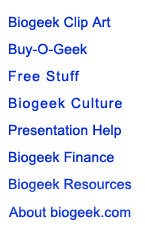| |
 |
 |
Try a biogeek template for free! |
|||||||||||||||||||
presentation help and tips |
|||||||||||||||||||||
 |
Here are some basic tips for making good presentations. Maybe you heard them before, but how many times have you seen a presentation that ignores them?
|
find help on the webHere are some links to presentation tutorials that you may find helpful. I like the Biology Seminar page from Old Dominion University. You will find a well organized page with lots of links to other sites that will help you with all aspects of giving effective presentations. Presenter University is sponsored by In Focus digital projectors and is more commercially oriented than the ODU site. But there are free downloads and trial versions of software add ons to help you with your presentation efforts so it's worth a look. Looking for a little esoteric fun? Try Symbols.com. This is a very comprehensive site, full of symbols old and new along with their meaning and the history of their development. Try http://www.presentations.com/ for a commercial site you will find a comprehensive site with sales of presentation equipment as well as helpful articles on giving presentations. Look for the speaker tips archive for a good free resource of speaking and presenting advice. Surf on over to Kodak's Planning Your Presentation site for a mini-course on giving presentations as well as suggestions on how to make your slides more effective. Lastly, although we don't really want to be a pimp for the Man, we might as well make it convenient to find the Microsoft PowerPoint official homepage so here it is. |
|||||||||||||||||||
Stop! You're on candid microphone!At a recent meeting, the chairman (a male) of the session gave the upcoming speaker a gracious introduction and then left the stage so that the speaker might begin. As the speaker was halfway through their introduction slide, strange sounds began to come from the sound system, interrupting the flow of the speakers presentation. As the sounds continued many of the men began to identify the now familiar sound and the audience was filled with muffled laughter and knowing smiles. When the Chairman returned, an associate informed him that his "biobreak" had been broadcast to the whole audience. Embarrassed but a good sport the chairmen waited until the end of the speakers talk, thanked her and apologized for his interruption. As this was a fairly large meeting there were plenty of witnesses and the chairman will probably not be allowed to forget this event as soon as he would like to. In the process of passing this story on, other people had similar stories to tell. The moral of this story is to remember the mic! With the wireless technology used today you have no idea where your comments and activities are being broadcast. Do you have a better story? Share it with us and your fellow biogeeks. Maybe you spare someone else from the humiliation that you ( or your "friend" suffered. |
|||||||||||||||||||||
Books that can help |
|||||||||||||||||||||
| If you are really serious about communicating your scientific results and ideas to an audience check out the ultimate book on the subject. |
|||||||||||||||||||||
| If you are looking for a basic "how to" book, try Say It with Presentations: How to Design and Deliver Successful Business Presentations. This is an up to date reference that includes sections on the newer multimedia aspects of presentations. While this book is targeted at business presentations, most of the concepts are clearly presented so that they will apply to any presentation. | |||||||||||||||||||||
|
copyright © 2003 Biografix/Gary Caviness |
|||||||||||||||||||||